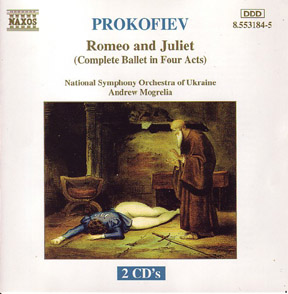
(845) 246-6944
· info@ArtTimesJournal.com
 |
Dancing in Verona
By
FRANK BEHRENS
ART
TIMES June 200
Having already considered
Shakespeare in opera and Shakespeare in Broadway musicals, I want to
consider this month what might be the most successful translation of
one of his plays into a ballet.
By the very nature of things, Shakespeare as ballet is pure
nonsense. How could the most gifted poet in the English-speaking world
survive the sea change into wordless dance? If the answer is “No way,”
then we might as well stop here. But if the question becomes, “How could
the spirit of the original survive as dance?” then we have a twofold
answer.
Then, of course, we have the second element: the music. If
one sets (say) “Titus Andronicus” with all its nightmarish aspects to
an electronic 1960-ish horror film score, it just might work on stage.
I would, however, feel disinclined to play a recording of the score
alone, thank you very much. But such a score would be as out of synch
with the story of “As You Like It” as setting that play in modern costumes
would be out of synch with the speech and world view of the plot and
characters.
In my mind, the most successful transfer of a Shakespeare
play to the ballet stage is Prokofiev’s “Romeo and Juliet.” With the
exception of a passage that one finds in his Symphony No. 1, “The Classical,”
only some of the Prokofiev score sounds like the music of Renaissance
Italy, the rest more “Soviet” than Medici or even Elizabethan.
For example, the wealthy Capulets are shown to be arrogant
capitalists and their music is ponderous and self-important. The fight
music is filled with the sound of percussion and brass under the swirling
of the strings, leading to the heavy death music as Mercutio falls dead
and the Duke enters to stop the fray.
The love pas de deux that makes up the Balcony Scene is in
the neo-romantic style and must be compared with Berlioz’ setting of
the same scene in his choral symphony
“Romeo et Julette.” The part of the ballet score called “the
young Juliet” is the perfect evocation of a girl feeling her first impressions
of “what it means to be a woman” in her society; but the music grows
up with the character, and Juliet’s music is quite different after the
love duet.
Unlike the opera of Gounod or the symphony of Berlioz, the
ballet cannot give Mercutio his Queen Mab speech. However, the clown
in him is movingly depicted by the halting “wounded” music to show his
actions after he is stabbed by Tybalt under Romeo’s arm. Yes, perhaps
Prokofiev could have let him DANCE the Queen Mab speech. However, alas,
music can never be that specific and such verbal sequences simply cannot
translate into dance.
Charles Gounod was going to share a problem with Berlioz
in the former’s opera “Romeo et Juliette” concerning the death scene.
In the Shakespeare original, Juliet wakes after Romeo dies from the
poison, speaks some lines, and then stabs herself. Fine for Shakespeare,
not so fine for a ballet in which the couple are expected to have a
pas de deux, if only a moribund one, before the curtain. However pressured
to do just that, Prokofiev held out for the Shakespearean ending and
won. Gounod, however, does give them a brief duet.
The book “101 Stories of the Great Ballets” by George Balanchine
and Francis Mason (Anchor Books, 1989) gives the scenarios and backgrounds
to several other balletic treatments of this ancient tale. While there
are about a half dozen videos of the Prokofiev treatment, I cannot find
any of the others.
The version choreographed by Anthony Tudor in 1943 uses the
music of Delius. This is appropriate for at least the one reason that
Delius composed an opera called “A Village Romeo and Juliet,” from which
the entr’acte “The Walk to Paradise Garden” is often played at “pops”
concerts. Do any of my readers know of a video of the Tudor treatment?